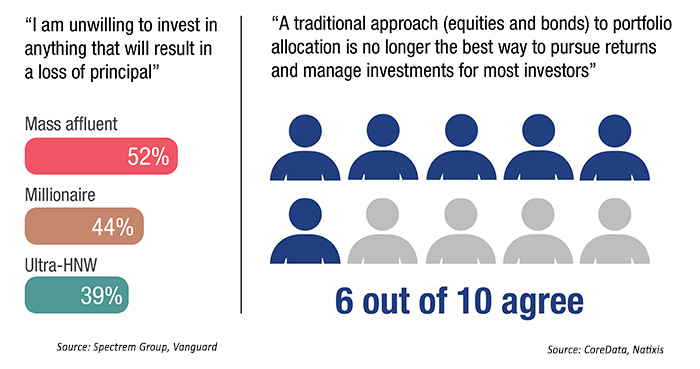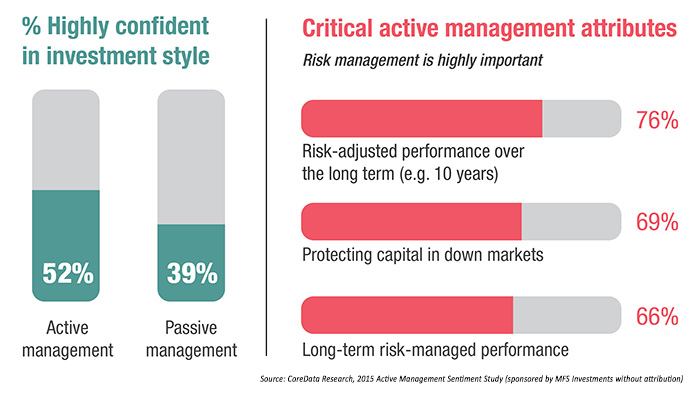Advisors prefer active management
Advisors prefer active management

Several studies assess advisor attitudes around portfolio management and risk mitigation for clients—showing a continued preference for actively managed strategies.
Editor’s note: This article first published in our magazine in October 2015, but it is perhaps even more relevant today. The S&P 500 finished 2017 with a ninth consecutive year of positive total returns (though volatility has returned in 2018), leaving advisors and investors wondering if and when the next bear market will appear. With the Trump administration’s policies generating hope that the economy will continue to improve—and also creating an unprecedented level of uncertainty—it is no time for advisors to decrease their emphasis on risk management for client portfolios.
“Index funds clearly have won the hearts and minds of many investors. Are there any reasons to even consider actively managed funds these days?” So said The Wall Street Journal in an article published on February 8, 2015.
They partially answered this question with the observation that, “Little surprise, then, that last year, people yanked $98.6 billion out of actively managed U.S.-stock mutual funds while putting $71.3 billion more into ‘passive’ ones that merely track an index.”
However, this opening salvo was quite misleading. The Journal article later acknowledged that the support for active management among professional investors and financial advisors was often much stronger than the massive funds flow statistics might suggest.
In addition, it must also be noted that there is a great deal of confusion in the business press when discussing “the active management debate.” The Journal article, and many others, frequently equate “actively managed mutual funds” with the entire universe of “active management.” This is simply not the case, as those mutual funds are usually restricted in their techniques/charter, stock universe, and tracking requirements, while holistic active portfolio management is not. The latter is usually primarily concerned with employing strong risk-management techniques in portfolio strategies while seeking favorable opportunities among a wide range of diversified asset classes.
That distinction noted, the Journal did cite many instances where actively managed funds could have an advantage versus passive funds:
“Many advisors still believe that at certain times, and for certain strategies, actively managed funds are superior to index funds. That is particularly true, they say, if the active fund has a good long-term track record. The lesson here? Historically, active managers have lagged behind benchmarks during long, strong bull markets. But they tend to make up lost ground when markets level off or suffer corrections.
“‘Active managers have more ways to play defense,’ says Tim Clift, chief investment strategist for Chicago-based Envestnet Inc., a firm that guides advisers on using active and passive funds. ‘They (active managers) don’t have the pedal to the metal when the markets are going up, and they put the brakes on more quickly when markets are going down.’”
In fact, several recent independent research studies have shown that more advisors are (1) moving a greater percentage of their book of business to fee-based services; (2) increasingly utilizing the services of third-party money managers; and (3) supportive of active investment strategies and risk management, despite the lengthy bull market.
TABLE 1: GROWTH OF ADVISOR FEE-BASED REVENUES AND AUM

Source: PriceMetrix, “The State of Retail Wealth Management 2017,” May 2018.
Why is this so?
Undoubtedly, a major reason is that financial advisors wish to deliver on the investment objectives, suitability parameters, and risk appetites of their clients—with a significant percentage of clients approaching or already in retirement. These clients, many burned twice in the 2000s by market meltdowns, are valuing capital preservation and slow and steady portfolio growth over “market-beating” outperformance (and all of its related risk).
Advisors are moving more of their books of business to fee-based services and increasingly utilizing the services of third-party money managers.
Vanguard Investments wished to take a look at a range of investor attitudes, segmented by net worth, during the very bullish equity market in 2013. While they saw that investors had “slowly become less risk-averse with the passing of time from the financial crisis, they remain tilted to the conservative side. Almost half agreed with the strong statement that they will not invest in anything that will result in a loss of principal.”
And, directly related to this, a Natixis “2015 Global Survey of Individual Investors” shows 70% of affluent investors are “looking for new portfolio solutions”—not wanting a repeat of steep portfolio drawdowns.
FIGURE 1: AFFLUENT INVESTORS SEEK NEW PORTFOLIO SOLUTIONS

Natixis presented updated research in 2017 in the study, “2017 Individual Investor Survey Trust.”
Among the study’s many findings, two statements stand out related to risk management and the “active versus passive debate”:
- “Understanding risk is the #1 area where most investors want the help of a financial professional. Risk is also the #1 item on the agenda of many financial professionals.”
- “In comparing the strengths and weaknesses of active and passive management, investment professionals see clear advantages for active managers in terms of generating risk-adjusted returns (66%). They also give the nod to active for taking advantage of short-term market movements (73%), as well as providing exposure to both non-correlated asset classes (73%) and emerging market opportunities (75%).”
The independent research firm that conducted the Vanguard research, Spectrem Group, updates its “Affluent/Millionaire Investor Confidence Index” monthly. Their tracking finds that while investor confidence among the affluent has improved during the 2009-2018 period, it is still consistently well below levels seen in 2006-2007 and is relatively unstable—prone to shift rapidly based on current market conditions, the political climate, and economic/geopolitical news. The “mood swings” seen among affluent investors are indicative of what many behavioral economists see as the “hangover effect” of the Great Recession.
Given this backdrop of conservative attitudes by many clients toward risk and capital preservation, financial advisors continue to find investment solutions in actively managed portfolio approaches.
Clients are valuing capital preservation and slow and steady portfolio growth over ‘market-beating’ outperformance.
CoreData Research, an independent third-party research provider, conducted another commissioned study of more than 1,000 financial advisors, institutional investors, and professional buyers in the first half of 2015. The survey finds that active management is the preferred broad investment approach for professionals—despite those significant investor flows into passive mutual funds in recent years.
According to the survey, close to 60% of U.S. professional investors surveyed say that actively managed strategies will play a significant role in their portfolios in the future. Fifty-two percent of the sample say they are “highly confident” in active strategies; the combination of “highly confident/confident” attributes average better than 90% for those surveyed. In comparison, only 39% are “highly confident” in passive strategies.
The survey also identifies the major criteria investment professionals are looking for in selecting active managers, with risk-management-related reasons identified as the top-ranking attributes.
FIGURE 2: FINANCIAL ADVISOR AND INSTITUTIONAL ATTITUDES

However, based on this and other data, there clearly is no “one size fits all” approach either for investment professionals or their investor clients. Many find that a combination of active and passive strategies, or a “core and satellite” approach, is a very viable alternative for modern-day portfolio management.
In May 2015, ThinkAdvisor reported on the findings of, yes, yet another study on the topic of active versus passive investment management approaches. The report was based on data from 600 wire-house, regional, independent, and registered investment advisors, plus data from 525 advisors focusing on just liquid alternatives. Howard Schneider, president of Practical Perspectives and co-author of the report, “Major Trends Driving Change in Portfolio Construction,” says, “Most advisors still tilt toward being primarily active or a blend between active and passive.”
The study release notes, “Indeed, more than 80% of the advisors surveyed indicated significant or moderate use of active management strategies. … While many financial advisors are increasingly gravitating to passively managed solutions (for some asset classes and sectors), active management remains a core pillar to how advisors build portfolios.”
What is the bottom line here?
The investor clients of financial advisors and wealth managers have shown an increased risk appetite during the lengthy bull market of 2009-2018. But most investors, as the 2015 Natixis study put it, have remained, “cautious, conflicted, and in need of guidance.”
The 2017 Natixis study adds, “Managing clients and their emotions is no easy task.”
They found that investors continue to be skeptical of the long-running bull market and “confidence may only run skin deep.”
They noted the following in their conclusions:
“In broader sentiment, we see what may be the lingering effects of the turmoil experienced by investors over the past ten years manifested in mixed emotions in how investors view risk, return, and their portfolios:
- “Despite a record run of low numbers for the VIX, investors are still concerned about the threat of volatility, with most believing it undermines their ability to achieve savings and retirement goals.
- “Despite an extended bull market globally, investors define risk as losing assets rather than losing out on investment opportunity.
- “Despite high hopes for investment returns, most say they will take safety over investment performance.”
The good news is that financial advisors have an increasingly complex array of portfolio alternatives, strategic tools, and third-party investment solutions at their disposal. Active management remains a vitally important component of meeting client objectives for a majority of advisors, particularly in addressing the core client concerns of managing risk and preserving capital over the long term.
This article first published in Proactive Advisor Magazine on October 1, 2015, Volume 8, Issue 1. Certain statistics were updated to reflect the most current data.
 David Wismer is editor of Proactive Advisor Magazine. Mr. Wismer has deep experience in the communications field and content/editorial development. He has worked across many financial-services categories, including asset management, banking, insurance, financial media, exchange-traded products, and wealth management.
David Wismer is editor of Proactive Advisor Magazine. Mr. Wismer has deep experience in the communications field and content/editorial development. He has worked across many financial-services categories, including asset management, banking, insurance, financial media, exchange-traded products, and wealth management.
